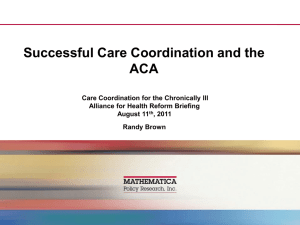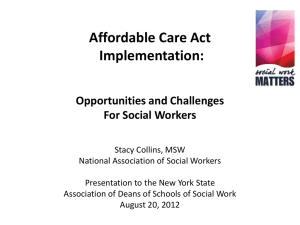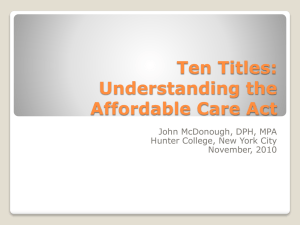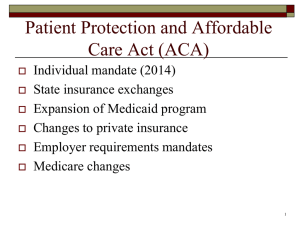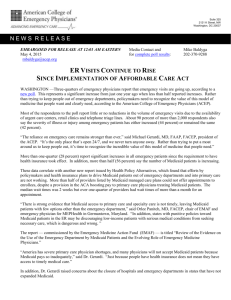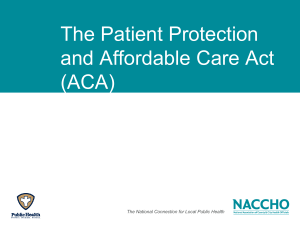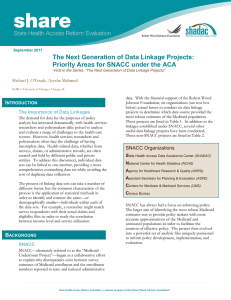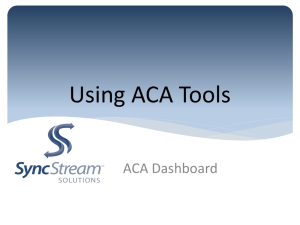The Affordable Care Act - Emergency Medicine Residents Association
advertisement
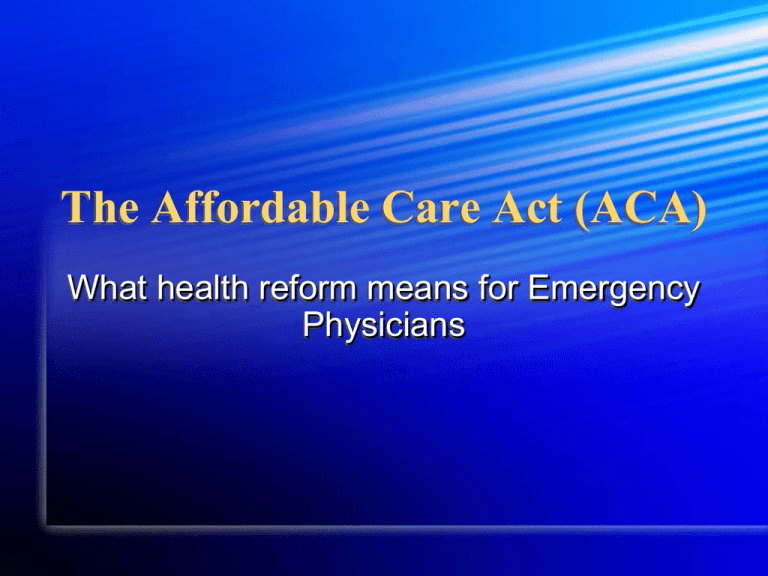
The Affordable Care Act (ACA) What health reform means for Emergency Physicians Main Provisions of ACA 1. 2. 3. 4. 5. Expanding Insurance Coverage Health Insurance Reform Improve Quality Contain Costs Consumer Protections Expanding Coverage Individual Mandate Employer Mandate 50 employees: Penalty/shared responsibility requirement for not offering adequate insurance Some premium subsidies for businesses with 25 employees who choose to offer insurance Expansion of Medicaid Own qualifying health insurance or pay fine Multiple exemptions (financial, religious, etc) 133% of FPL Simplified CHIP enrollment Other Expanded Coverage Dependent coverage up to 26y Federal funding to preserve employer insurance for early retirees Prescription drug discounts and tax rebate for seniors who hit Medicare donut hole Access to Primary Care Increased loan repayment and funding for primary care physicians and midlevel providers practicing in shortage areas Increased payments to rural health providers Increased payments to primary care physicians under Medicaid Health Insurance Reform State-based/Regional Health Insurance Exchanges Income-based premium and cost sharing (up to 400% FPL) Separate exchanges for small businesses Medical Loss Ratios 80-85% of premiums must be spent on patient care Improving Quality Comparative Effectiveness Research Patient-Centered Outcomes Research Institute (PCORI) Demonstration Projects Center for Medicare and Medicaid Innovation Bundled payment pilot program ACO development Medical Home Cost Containment Medicare payment reform and restructuring (selected provisions) Shared cost-savings for ACOs Cost of care of single patient shared between all parties within ACO (clinic & hospital based physicians, ancillary staff) Also shared losses Value-based purchasing program Payments linked to quality outcomes Reduced payments for readmissions & hospital-acquired infections Potential for bonus payments Independent Payment Advisory Board (IPAB) Recommendations on cost-reduction (primarily of physician services) Cost Containment Reduce Medicare and Medicaid Disproportionate Share Hospital payments Prohibit federal Medicaid payment to states for health-care acquired conditions Increased anti-fraud activities Consumer Protections Removal of pre-existing condition exclusions Prohibit arbitrary rescissions of health care No lifetime limits on coverage Regulation of annual limits on coverage Patient choice of provider within network Removal of barriers to emergency care No higher co-payments for out-of-network emergency care Health plans must reimburse out-of-network providers rendering emergency care Emergency Medicine & ACA Essential Health Benefits Package Primary, preventative, emergency services Prudent Layperson Reimbursement provided for person with average medical knowledge who presents to ED with presumed emergency Pilot projects for trauma regionalization Increased funding for emergency medicine and systems research The ACA does a lot more… For Further Information: http://www.healthcare.gov/law/about/order /byyear.html http://www.kff.org/healthreform/8061.cfm Impact of ACA on EM Insurance ≠ Access ACA does little to improve immediate physician supply or access to care Demonstration projects (eg. medical home) only promise to improve efficiency influx of newly-insured patients will increase demand for health resources before increases in efficiency realized Exacerbation of projected physician shortages Shortage of 91,500 physicians by 2020 and 130,600 by 2025 (AAMC 2008) Crosses all specialities: -46K primary care Fewer practices taking Medicaid (and Medicare) due to poor reimbursements, though ACA expands the number covered Strain on Emergency Systems Closure of ~27% of EDs over last 20 years, while ED visits continue to increase (Hsai 2011) Insured patients utilize emergency services more than uninsured (NCHS 2010; Tang 2010) Medicaid patients have highest annual rate of ED visits Reflects difficulty in obtaining access in to primary care services in the community Increasing number of insured under the ACA will increase demand for emergency services ACOs Current payment system focuses on individual services and providers More services/tests, more pay Does not amount to better quality Attempt to incentivize higher quality, more efficient care (lower costs, higher pt satisfaction) Rewards coordinated care based on outcomes Income incentives apply to primary physicians only Hospitals/specialists still reimbursed by volume Bundled payments currently only demonstration project Provider responsibility to improve outcomes, no patient responsibility ACOs, Where is the ED? Will emergency services be bundled with hospitals or outpatient services? ED plays a transient role in care > outcomes depend on subsequent hospital or outpatient care Income redistribution without control Often difficult to coordinate care between ED and primary care practices PCP’s not always able to be contacted Patients often don’t f/u Out-of-network patients Medicare/Medicaid Payment EDs often provide care at or below actual costs low reimbursement rates ACA increases patients covered without increase in tax revenue > likely increase in non-reimbursed care new penalty programs (eg. hospital acquired infections, poor outcomes) No solution for SGR ACEP’s position You can find ACEP’s position statements at: http://www.acep.org/advocacy/federalissu es/ (under the Health Reform heading) References Hsia, R., Kellerman, A., Shen, Y. Factors Associated With Closures of Emergency Departments in the United States Renee JAMA. 2011; 305(19): 1978-1985. The Complexities of Physician Supply and Demand: Projections Through 2025 (PDF). 2008. AAMC Garcia, TC., Bernstein, AB., Bush, MA. Emergency Department Visitors and Visits: Who Used the Emergency Room in 2007? NCHS Data Brief. May 2010; (38) Tang, N. etal. Trends and Characteristics of US Emergency Department Visits, 1997-2007. JAMA. 2010 August 11; 304(6): 664–670. Kaiser Family Foundation. Summary of New Health Reform. 2010. http://www.kff.org/healthreform/8061.cfm Gerardi, M. The ACA-Driven ACO Movement: Implications for Emergency Medicine - EM Practice Management & Health Policy Section Newsletter, March 2011. http://www.acep.org/Content.aspx?id=77674
